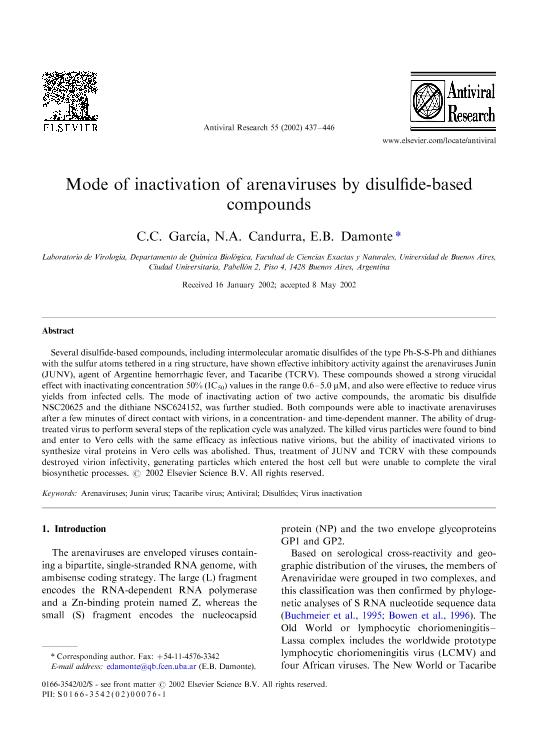Mostrar el registro sencillo del ítem
dc.contributor.author
Garcia, Cybele

dc.contributor.author
Candurra, Nélida A.
dc.contributor.author
Damonte, Elsa Beatriz

dc.date.available
2020-03-30T14:03:00Z
dc.date.issued
2002-12
dc.identifier.citation
Garcia, Cybele; Candurra, Nélida A.; Damonte, Elsa Beatriz; Mode of inactivation of arenaviruses by disulfide-based compounds; Elsevier Science; Antiviral Research; 55; 12-2002; 437-446
dc.identifier.issn
0166-3542
dc.identifier.uri
http://hdl.handle.net/11336/101254
dc.description.abstract
Several disulfide-based compounds, including intermolecular aromatic disulfides of the type Ph-S-S-Ph and dithianes with the sulfur atoms tethered in a ring structure, have shown effective inhibitory activity against the arenaviruses Junin (JUNV), agent of Argentine hemorrhagic fever, and Tacaribe (TCRV). These compounds showed a strong virucidal effect with inactivating concentration 50% (IC50) values in the range 0.6 /5.0 mM, and also were effective to reduce virus yields from infected cells. The mode of inactivating action of two active compounds, the aromatic bis disulfide NSC20625 and the dithiane NSC624152, was further studied. Both compounds were able to inactivate arenaviruses after a few minutes of direct contact with virions, in a concentration- and time-dependent manner. The ability of drugtreated virus to perform several steps of the replication cycle was analyzed. The killed virus particles were found to bind and enter to Vero cells with the same efficacy as infectious native virions, but the ability of inactivated virions to synthesize viral proteins in Vero cells was abolished. Thus, treatment of JUNV and TCRV with these compounds destroyed virion infectivity, generating particles which entered the host cell but were unable to complete the viral biosynthetic processes.
dc.format
application/pdf
dc.language.iso
eng
dc.publisher
Elsevier Science

dc.rights
info:eu-repo/semantics/openAccess
dc.rights.uri
https://creativecommons.org/licenses/by-nc-sa/2.5/ar/
dc.subject
arenavirus
dc.subject
Virus inactivation
dc.subject
disulfides
dc.subject
Junin virus
dc.subject
Tacaribe virus
dc.subject
Antiviral
dc.subject.classification
Virología

dc.subject.classification
Ciencias Biológicas

dc.subject.classification
CIENCIAS NATURALES Y EXACTAS

dc.title
Mode of inactivation of arenaviruses by disulfide-based compounds
dc.type
info:eu-repo/semantics/article
dc.type
info:ar-repo/semantics/artículo
dc.type
info:eu-repo/semantics/publishedVersion
dc.date.updated
2020-03-25T14:37:27Z
dc.journal.volume
55
dc.journal.pagination
437-446
dc.journal.pais
Estados Unidos

dc.journal.ciudad
United Kingdom
dc.description.fil
Fil: Garcia, Cybele. Consejo Nacional de Investigaciones Científicas y Técnicas. Oficina de Coordinación Administrativa Ciudad Universitaria. Instituto de Química Biológica de la Facultad de Ciencias Exactas y Naturales. Universidad de Buenos Aires. Facultad de Ciencias Exactas y Naturales. Instituto de Química Biológica de la Facultad de Ciencias Exactas y Naturales; Argentina. Universidad de Buenos Aires. Facultad de Ciencias Exactas y Naturales. Departamento de Química Biológica. Laboratorio de Virología; Argentina
dc.description.fil
Fil: Candurra, Nélida A.. Universidad de Buenos Aires. Facultad de Ciencias Exactas y Naturales. Departamento de Química Biológica. Laboratorio de Virología; Argentina
dc.description.fil
Fil: Damonte, Elsa Beatriz. Universidad de Buenos Aires. Facultad de Ciencias Exactas y Naturales. Departamento de Química Biológica. Laboratorio de Virología; Argentina. Consejo Nacional de Investigaciones Científicas y Técnicas. Oficina de Coordinación Administrativa Ciudad Universitaria. Instituto de Química Biológica de la Facultad de Ciencias Exactas y Naturales. Universidad de Buenos Aires. Facultad de Ciencias Exactas y Naturales. Instituto de Química Biológica de la Facultad de Ciencias Exactas y Naturales; Argentina
dc.journal.title
Antiviral Research

dc.relation.alternativeid
info:eu-repo/semantics/altIdentifier/url/https://www.sciencedirect.com/science/article/abs/pii/S0166354202000761
dc.relation.alternativeid
info:eu-repo/semantics/altIdentifier/doi/http://dx.doi.org/10.1016/S0166-3542(02)00076-1
Archivos asociados
